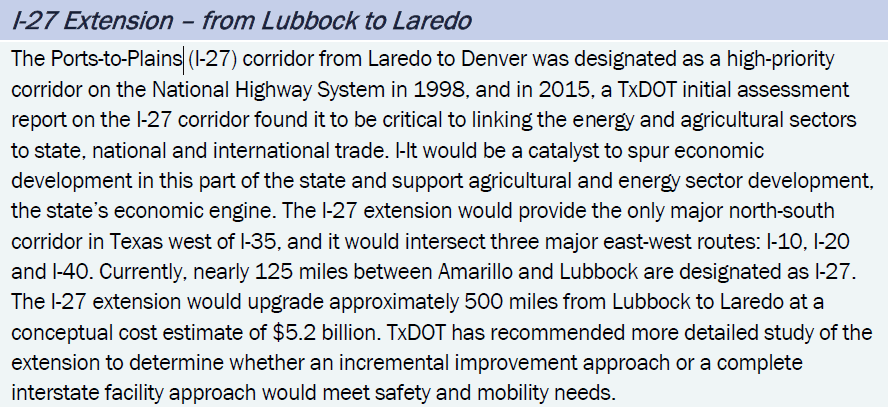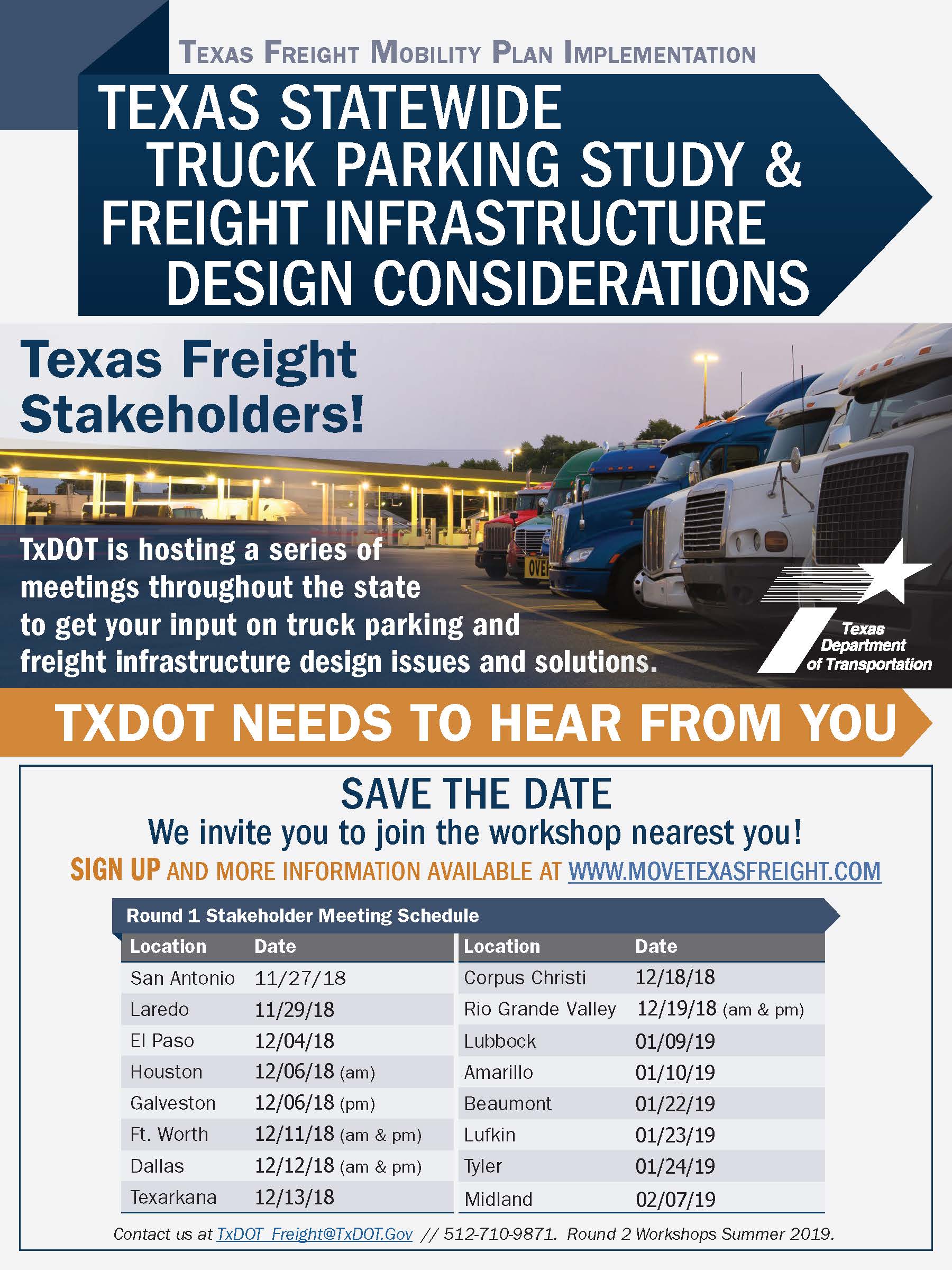|
Contents
Interstate 27 History
Interstate 27 currently exists between Amarillo and Lubbock in Texas. Interstate 27 was not part of the original Interstate Highway System chosen in the 1950's but was authorized with the Federal-Aid Highway Act of 1968. H. Mahon, member of the U.S. House of Representatives from 1935 to 1979 and chairman of the House Appropriations Committee after 1964, helped secure funding for the road. Texas officially designated the highway in early 1969. The final section of I-27 built was through Lubbock, and was completed on September 3, 1992.
Extension of Interstate 27
The Ports-to-Plains Alliance first initiated discussion about the potential of an extension of Interstate 27 along the Ports-to-Plains Corridor in 2014. This led to Texas Department of Transportation's Initial Assessment Report: Extension of I-27/Ports-to-Plains Corridor published in November 2015. Click Here to Download the Initial Assessment Report.
The Initial Assessment Report, assessed the Ports-to-Plains Corridor in Texas for 1) existing conditions; 2) potential upgrade options; 3) a summary of public outreach and reaction; and, 4) potential next steps for TxDOT to consider toward further planning, public outreach and corridor development, using four segments (see graphic).

Conclusions of the Initial Assessment Report:
Extension of I-27/Ports to Plains Corridor
- “Overwhelmingly, stakeholders expressed the urgency in TxDOT engaging in a new update of prior corridor studies, focusing on an extension of I-27, rather than upgrading incrementally the I-27/P2P corridor.”
- “Investments have been made within the corridor to improve safety and mobility; however, there are still sections that need to be addressed.”
- “Some areas along the corridor have seen notable population growth and growth in the number of passenger cars and especially trucks and are projected to continue to grow. This translates to more demands on the transportation system.”
- “To bring the entire Ports-to-Plains corridor to interstate standards would require a significant financial commitment from both the state and local communities.”
In the larger statewide freight planning effort, the Texas Freight Mobility Plan, November 2017, identified the I-27 Extension from Lubbock to Laredo as one of two Strategic Freight Projects for Texas.
Conclusions of the Texas Freight Mobility Plan
- “In 2015, a TxDOT initial assessment report on the I-27 corridor found it to be critical to linking the energy and agricultural sectors to state, national and international trade.”
- “I-27 would be a catalyst to spur economic development in this part of the state and support agricultural and energy sector development, the state’s economic engine.”
- Strategic Freight Projects and Initiatives
- “Strategic recommendations are significant investments that will shape the state’s future freight transportation demands as well as address current unmet needs.”
- “Some strategic projects rise to a higher level due to the potential impact they have on statewide freight movements and economic competitiveness.”

Designation as a Future Interstate
Future Interstate Designation is a federal designation which identifies certain High Priority Corridors as future components of the Interstate Highway System. To date, all or a portion of twenty-two (22) or twenty-five percent (25%) of the High Priority Corridors have a Future Interstate Highway Designation.

Download Map of Designated Future Interstates from FHWA
The Ports-to-Plains Alliance includes three High Priority Corridors on the National Highway System: Corridor No. 14 - Heartland Expressway; Ports-to-Plains Alliance - Corridor No. 38; and Corridor No. 58 – Theodore Roosevelt Expressway.
Federal law allows Future Interstate Designation for existing High Priority Corridors on the National Highway System by either administrative action of the Federal Highway Administration (FHWA) or congressional action. The administrative process requires each segment designated must have an approved final environmental document covering the route and project action must be ready to proceed with design at the time of designation and the state(s) must make a commitment to complete the highway to Interstate design standards within twenty-five (25) years from the designation as a future Interstate.
The Board of Directors has chosen the congressional process. Designation as a Future Interstate under the congressional process requires no specific timeline nor financial commitment by the state(s). The project can continue to develop with available funding without arbitrary deadlines which might prove difficult for states to support. This would allow states to continue to develop the corridor as they have in the past.
As an example, when Ports-to-Plains was designated as a High Priority Corridor on the National Highway System there was no specific timeline or financial commitment by the state departments of transportation. The Ports-to-Plains Corridor, since designation as a High Priority Corridor, has seen over $2.5 billion in state and federal investment including over $0.95 billion in Texas.
Future Interstate Designation will continue to allow the corridor to be developed incrementally as in the past but will limit the need to reconstruct to a different standard in the future. Investments will be made with the interstate standard in mind as designs are completed.
Board Priorities
Ports-to-Plains Alliance Board of Directors has identified a priority of obtaining Designation as a Future Interstate for the extension of Interstate 27 between Lubbock and Laredo, Texas. This priority was identified because of various reasons including the levels of trade between Texas and Mexico, the importance of energy production to the Texas and U.S. economy and the strategic priority of this segment identified within the Texas Freight Mobility Plan.
The Board of Directors also established a priority of continuing to advocate expansion of the entire Alliance corridor between Mexico and Canada. This includes the historical advocacy at state and federal levels for four-lane or better expansion.
The Argument in Support of Designation
In a July 1954 speech, President Dwight D. Eisenhower asked for help in devising a Grand Plan for upgrading the Nation's highways - Federal, State, and Local. The President listed the problems to overcome:
- Safety - an annual toll of nearly 40,000 killed and 1.3 million injured
- Congestion - wastes billions of hours in detours and jams amounting to billions of dollars in productive time
- Courts - civil suits related to traffic clog up our courts
- Economy - bad roads nullify the efficiency in the production of goods by inefficiency in their transport
- Defense - "the appalling inadequacies to meet the demands of catastrophe or defense, should an atomic war come"
President Eisenhower's 1963 memoir, Mandate for Change 1953-1956, contained a prediction based on the original intent:
“More than any single action by the government since the end of the war, this one would change the face of America... Its impact on the American economy - the jobs it would produce in manufacturing and construction, the rural areas it would open up - was beyond calculation.”
The future interstate designation today of any of the proposed options would serve the same purposes.
Today, feasibility studies are focused on historical data. The typical elements of a feasibility study are as follows:
- study various alternatives
- analyze current and future traffic
- analyze potential environmental problems
- develop cost estimates
- determine feasibility
If feasibility studies were required before the original interstate system was built, the historical data would not have resulted in a positive feasibility.



What Can You and Your Community Do?
Having support from you, your community and its elected officials, your MPOs, your state DOT and your congressional delegation will be the key to success of this effort to designate an extension of Interstate 27 as a future interstate.
Here are some specifics:
- Texas communities can participate in the Interstate 27 Extension Legislative Day, hosted by Ports-to-Plains Alliance in Austin, TX on March 7, 2019
- Participate in the Ports-to-Plains Alliance Washington DC Fly-in in April, 2019 (Dates TBD)
- Consider or Update a Resolution Supporting the Designation of the Extension of Interstate 27 in your state as a Future Interstate
Download Draft Resolution (Please send executed resolutions to Joe Kiely at joe.kiely@portstoplains.com.
Texas Statewide Truck Parking Study & Statewide Infrastructure Design Considerations

|